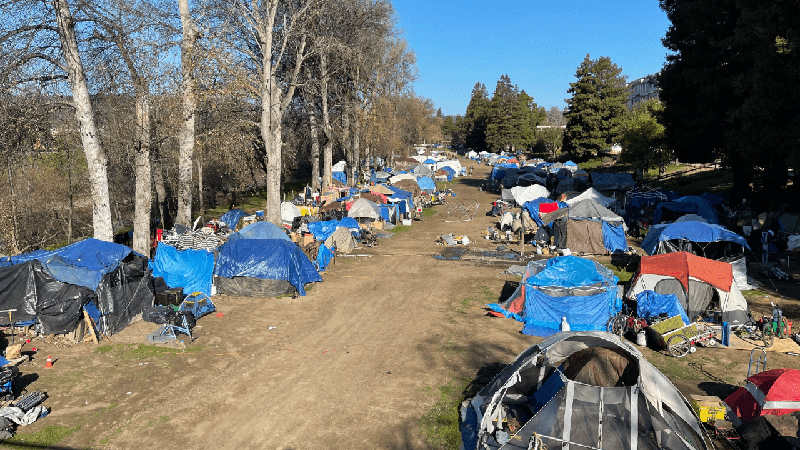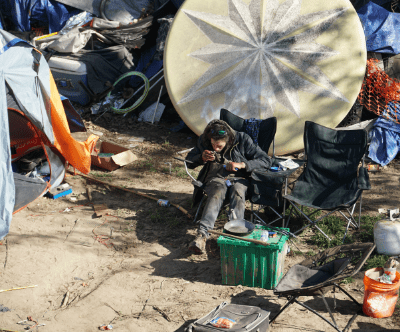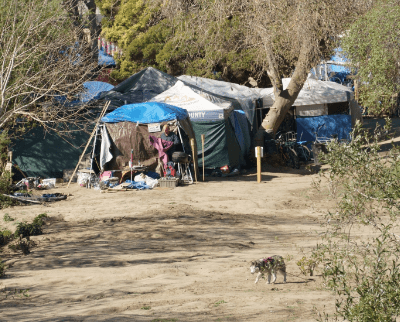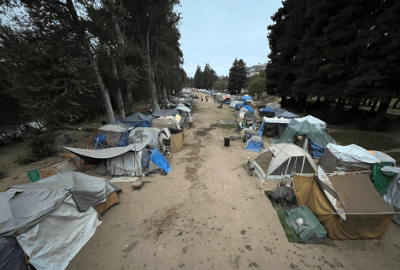As the population of unhoused individuals and families in Santa Cruz has exploded, officials from the City of Santa Cruz and Santa Cruz County tackle the issue.

A city-sanctioned homeless encampment directly adjacent to county government offices and across the San Lorenzo River from the heart of downtown Santa Cruz. Photo by Peggy Dolgenos
BY: Grace Stetson
For the past two years, anyone living in or visiting Santa Cruz has seen evidence of the county’s growing unhoused population: some 300 tents clustered in the San Lorenzo Park Benchlands. On either side of this massive, city-sanctioned homeless encampment—less than a mile apart—are two centers of government: the county offices right next door, and the downtown Santa Cruz City Hall.
While some may want to assign responsibility for addressing this humanitarian crisis to one of these entities, the actual situation is more complex. Tackling homelessness is a joint effort between the county and its cities, and one without a streamlined plan—made all the more difficult without updated data.
In California as of January 2020—the most recent data currently available—there were an estimated 161,548 persons statewide experiencing homelessness on any given day. A report by the U.S. Interagency Council on Homelessness included a breakdown showing that these people include families (8,030), veterans (11,401), unaccompanied young adults (12,172) and individuals experiencing chronic homelessness (51,785).
These numbers reflect the largest homeless population in the United States, both as an overall number and as a percentage of the state’s total population. Many experts expect that those numbers have skyrocketed in the two years since, in part due to the pandemic and its effects.

Earlier this year, on Feb. 28, Santa Cruz County conducted its first Point-in-Time (PIT) Count since 2019. When the results are released later this summer, this early morning tally of the unhoused will assess how much that population has exploded here in Santa Cruz. The data from the tally will show a breakdown of where the homeless population lives, who they are, and how the respective city and county agencies can better help them on the path to supportive services and permanent supportive housing.
For now, however, it’s important to discuss some of the major questions, and what we know—and don’t—about how to address the issue.
Who are the key players?
These are the two primary organizations:
• The Housing for Health Division, run by Santa Cruz County officials
• The Homelessness Response Team, overseen by the Santa Cruz city manager
And these are the two major names to know:
• Robert Ratner, the director of Housing for Health (H4H)
• Larry Imwalle, the city of Santa Cruz’s homelessness response manager
Ratner came to the division in November 2020 from Alameda County Health Care Services, where he had worked as a housing care manager for nearly 14 years. Imwalle began his role with the city of Santa Cruz in October 2021, following 14 years as the executive director for the nonprofit organization ACTION Council of Monterey County.
With both men joining local efforts to address homelessness just within the last three years, they’ve had to dive in headfirst—which can be difficult with all the factors that need to be addressed.
“This is an ongoing conversation,” Ratner said, when asked who is responsible for what and how to plan to address the issues. “People change roles and positions, our Board of Supervisors and City Council have lots of ideas…in the absence of a formal written agreement, it’s an interpretation of prior verbal or other understandings, which can change over time.”
Imwalle agrees, noting that the “space is evolving” not just here, but across California: “Cities are having to play a role that they haven’t historically—it’s a case of health, housing, human services, and all of the things that homelessness touches.”
Why does the city of Santa Cruz have so much oversight?
While the city of Santa Cruz has only 24 percent of the county’s total population, more than 50 percent of the county’s homeless population resides within the city limits. This could be for many reasons, some of them fairly straightforward:

Imwalle said the city has stood up to offer more services over the course of the pandemic than in years past, and is committed to more investment.
“We have a much more active role, regardless of the abstract concept of whose responsibility it is, to the magnitude and gravity of the issue,” he said.
City spokesperson Elizabeth Smith further noted that the city of Santa Cruz (and the other cities within the county) are more attuned to the needs of all the people who live within the city limits, and how they can coexist.
“How do we manage the magnitude of the situation, not only in providing support services, but also managing and helping to support the rest of the community?” she asked. “This is a byproduct of human suffering, which is not acceptable…that’s another dimension when we talk about our responsibilities that we take very seriously.”
Does the county focus on specific areas?
In short, yes, but the answer does get more complex.
All three officials explained what the breakdown has historically been:
For Smith, there was previously a more direct split: The county focused on health and human services, whereas the city focused on infrastructure, including toilets and garbage services. Those separations became more jumbled during the pandemic.
“You have got to have municipalities step up during the pandemic,” she said.
'Fundamentally, for me, the county should bear most of the responsibility for those services that help people get on the path to permanent housing.'
Robert Ratner
As Imwalle explained, the city is focusing primarily on adding capacity to emergency and transitional shelter options. Ratner believes the county is looking toward more permanent housing solutions and health services.
“Fundamentally, for me, the county should bear most of the responsibility for those services that help people get on the path to permanent housing, and should be responsible for funding service-enriched shelters,” Ratner said.
Where does funding come from, and how is it broken down?
Funding to address homelessness relies on data. Although the PIT count is just a snapshot of a more complex situation, it also provides counties and municipalities across the country the opportunity to get more federal funding to address homelessness.
However, there isn’t a specific dollar figure assigned to each unhoused individual.
Since 2018, the state’s Interagency Council on Homelessness has been responsible for administering the Homeless Emergency Aid Program (HEAP), a one-time $500 million block grant program. The city of Santa Cruz received $14.6 million in funding toward homelessness services in 2022 from HEAP. Obviously, even that large number doesn’t mean the issue will be solved overnight.
'We have to be demonstrating our coordinated and collaborative capacity to be more successful and attract additional resources.'
Larry Imwalle
There are really unprecedented levels of investment in this area, and it’s not a problem that’s ever been this bad,” said Smith. “It's a systemic problem that we're trying to manage, but that's all we can do at the local level was manage — we can't solve the problem at the local level.”
As Ratner points out, “How big of a program can we get going if we don’t know any predictability? You end up putting the risk on the county and providers if you start a program, but you’re not sure you’re going to be able to sustain it.”
What are the plans moving forward?
As city and county agencies work to determine who does what, and with what funding, it goes back to one word for both Ratner and Imwalle: collaboration.

“There’s not a clear playbook, but, in my view, the communities that are geographically making the most progress are the ones where jurisdictions, nonprofits and private-sector folks get a better understanding of how and when they can contribute, and what their core areas of contribution are,” Ratner said.
Imwalle believes it’s “essential” to continue working together across agencies to better address the impact of the issue: “While there's some bright lines, there is a lot of gray area, and that requires a kind of collaboration, so that we can utilize the resources we have efficiently.”
He adds, “We have to be demonstrating our coordinated and collaborative capacity to be more successful and attract additional resources.”
Looking forward, even as all parties work diligently to address homelessness, Smith said the issue continues to be “visibly explosive.”
“It’s not getting less, it’s getting more—and so much more intense,” she said. “It exceeds any one resource.”
Long form articles which explain how something works, or provide context or background information about a current issue or topic.